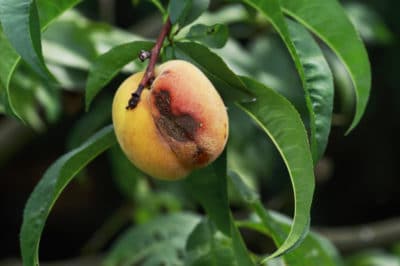Symptoms of Bacterial Spot in Peaches
Bacterial spot is often confused with peach scab because the symptoms are similar. While both of these conditions cause spots on the fruit, peach scab lesions are rounder and have a velvety, greenish-brown color and the lesions remain on the surface without causing pitting.
Lesions of bacterial spot are more irregular in shape and cause pitting in the surface of the fruit as well as cracks which exude a gummy substance. This damage to the surface of the fruit then creates an entryway for other pathogens such as brown rot.
The bacterial spot pathogen also affects the leaves of the tree, unlike peach scab. With bacterial spot, leaves develop irregular-shaped, dark-colored areas which can later fall out of the leaf, leaving a hole. Leaf lesions are often located at the tip of leaves or along the mid-rib.
The bacterial spot pathogen overwinters on the tree in the tips of branches where it also creates lesions with a gummy residue.
Solutions for Bacterial Spot on Peach Trees
Bacterial spot disease is spread through a combination of moisture and injuries to the bark of the tree. Where the tree has nicks or lacerations, rain water and mist from fog and irrigation can transport the pathogen into the tree.
Avoid planting peach trees where they will be subjected to strong winds and sand which can cause abrasion to the tree bark. Trees planted along dirt roads are often more likely to develop bacterial spot due to injury from rocks kicked up by passing traffic.
Plant trees away from sandy areas and dirt roads and avoid injuring the base of the tree with weed-eater string lines when cutting weeds.
Some varieties of peach are resistant to bacterial spot, and if you live in an area where this disease is problematic, consider planting a resistant varieties. These include:
- Belle of Georgia
- Earliglo
- Redkist
- Sunhaven
- Harbinger
- Encore
Prune out branches and twigs showing gummy residues, and fertilize and water the tree properly to keep it growing vigorously.
Spraying peach trees for control of bacterial spot is only marginally helpful. However, copper-based bacterial sprays and oxytetracycline, an antibiotic, are sometimes useful.
Fruit damaged by bacterial spot is often still edible if you simply peel off the skin and cut out any other damage.
